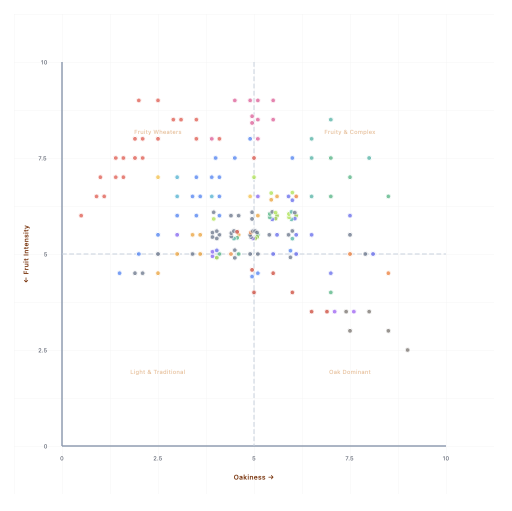Ever wondered where your favorite bourbon sits on the flavor spectrum? Or struggled to find a whisky similar to one you love? We’ve created something special for whisky enthusiasts: an interactive flavor map that plots over 200 bourbons and American whiskeys by their two most defining characteristics—fruit intensity and oakiness.
What Makes This Different?
Unlike traditional tasting notes that leave you guessing, our Whisky Flavor Map gives you a visual, interactive way to explore the whisky landscape. Every bottle is plotted on a grid where:
- The vertical axis represents fruit intensity (think cherry, apple, citrus, berry notes)
- The horizontal axis represents oakiness (vanilla, wood tannins, char, leather, tobacco)
This creates distinct flavor zones that help you understand not just what a whisky tastes like, but how it compares to everything else in your collection.
The Five Flavor Zones
1. Fruity Wheaters (Top Left)
This is where the sweet, approachable wheated bourbons live. Pappy Van Winkle, Weller, Maker’s Mark, and Old Fitzgerald dominate this quadrant with their signature cotton candy sweetness and minimal oak influence. If you love dessert-forward whiskeys, start here.
2. Fruity & Complex (Top Center)
Four Roses recipes excel in this space with what enthusiasts call “fruit bomb” profiles. Blanton’s and younger Eagle Rare expressions also cluster here. These whiskeys balance beautiful fruit notes with enough oak to add complexity without overpowering.
3. Fruity with Heavy Oak (Top Right)
Premium aged expressions like Michter’s 10-year and 20-year, Baker’s 13-year, and Knob Creek’s 18 and 21-year offerings maintain gorgeous fruit character despite heavy oak influence. These are unicorns—whiskeys that aged long enough to pick up serious wood character without losing their soul.
4. Classic Traditional (Center)
This is bourbon’s sweet spot. Old Forester, Knob Creek 9-year, Wild Turkey 101, and standard Buffalo Trace sit here—balanced, versatile, and perfect for both sipping and mixing. If someone asks “what does bourbon taste like?”, pour them something from here.
5. Power Bourbons (Bottom Center)
George T. Stagg, Stagg Jr., William Larue Weller, and Thomas Handy Rye dominate this zone. These are spice-forward, oak-driven powerhouses where fruit takes a back seat to intense wood, pepper, and heat. Not for beginners, but beloved by enthusiasts.
6. Oak Dominant (Bottom Right)
The Orphan Barrel series, Jack Daniel’s aged releases, and Calumet’s 16 and 18-year expressions live here. These whiskeys are heavily influenced—sometimes overwhelmed—by oak. They’re polarizing: some love the tannic, woody character, others find them over-aged.
The AI-Powered Search Feature
Here’s where things get really interesting: you can search for ANY whisky, even if it’s not already on the map.
Type in a bottle name—say, “Redwood Empire Lost Monarch” or “Old Elk Blended Straight Bourbon”—and our AI analyzes professional reviews to calculate its flavor profile. Within seconds, it plots the whisky on the map and tells you:
- Its oakiness score (0-10)
- Its fruit intensity score (0-10)
- Which flavor zone it falls into
- The three closest whiskeys already on the map
This means you can discover similar bottles you’ve never tried, or understand how that new craft distillery’s release compares to established favorites.
How to Use the Map
For Finding Similar Bottles
Scenario: You love Eagle Rare 10-year and want something comparable.
- Hover over Eagle Rare on the map (top-center area)
- Note its position: moderate oak (3.5), high fruit (7)
- Look at nearby dots—you’ll find Blanton’s Original, Rock Hill Farms, and Elmer T. Lee
- Try one of those next!
For Understanding Your Palate
Scenario: You’ve tried several whiskeys but don’t know your preference pattern.
- Click to filter by the brands you’ve tried
- See where they cluster on the map
- If they’re all in the top-left, you’re a wheater fan
- If they spread across the center, you like balance
- If they’re bottom-center, you chase bold, spicy heat
For Exploring New Territory
Scenario: You always drink wheated bourbon but want to branch out.
- Start at your comfort zone (Weller, Maker’s)
- Move slightly right or down on the map
- Try Four Roses Small Batch (more oak, still fruity)
- Gradually work toward the center or other zones
- Expand your palate systematically
The Data Behind the Map
Every bottle’s position is based on professional tasting notes from respected sources like Bourbon Culture and Breaking Bourbon. We analyzed:
- Mashbill composition (wheated vs. high-rye vs. traditional)
- Age statements and maturation details
- Proof levels (higher proof often means more spice/oak emphasis)
- Tasting notes from multiple reviewers
- Community consensus on flavor profiles
The result? A map that actually reflects how these whiskeys taste, not just marketing descriptions.
Interactive Features You’ll Love
🔍 Filter by Category: Only want to see Buffalo Trace products? Click the filter. Comparing wheated bourbons? Toggle that category. Looking at premium expressions? There’s a button for that.
💡 Hover for Details: Mouse over any dot to see the whisky’s name, proof, and category without cluttering the map.
⭐ Custom Searches: When you search for a whisky, it stays on the map with a special gold highlight until you clear it, making comparisons easy.
Try It Yourself
→ Explore the Interactive Whisky Flavor Map
Spend 10 minutes clicking around. Search for bottles you’re curious about. Filter by your favorite distilleries. Find your comfort zone and explore the edges.
Note: While we’ve mapped over 200 bottles based on professional reviews, remember that palate is personal. Your perception of oakiness or fruit might differ slightly from ours or other reviewers. Use this map as a guide, not gospel—and always trust your own taste buds.
Drink responsibly. Explore curiously. Find your next favorite pour. 🥃
The Whisky Flavor Map is continuously updated. Bookmark it and check back as we add new releases and expand into scotch, Irish whiskey, and world whiskey categories.

